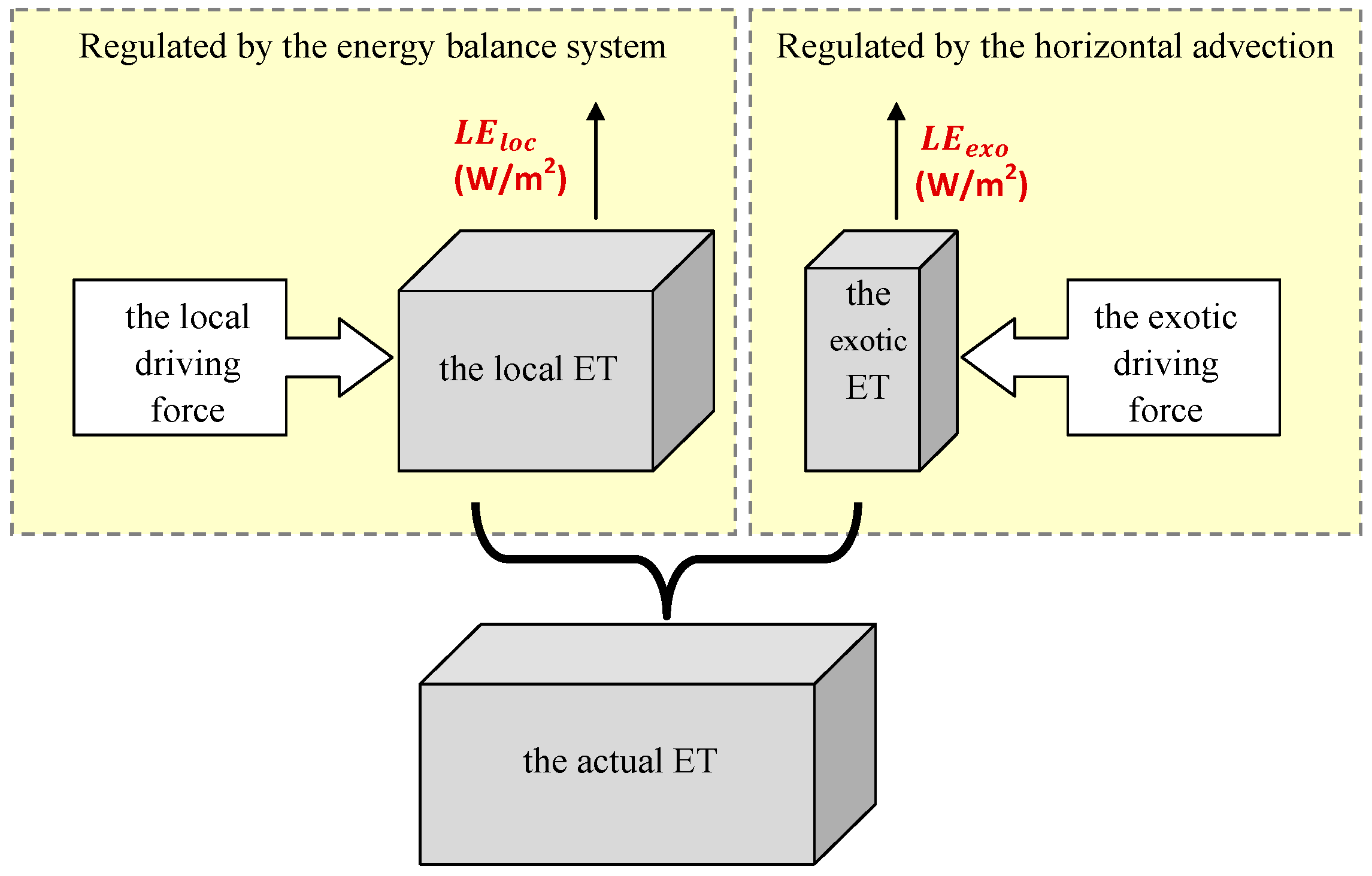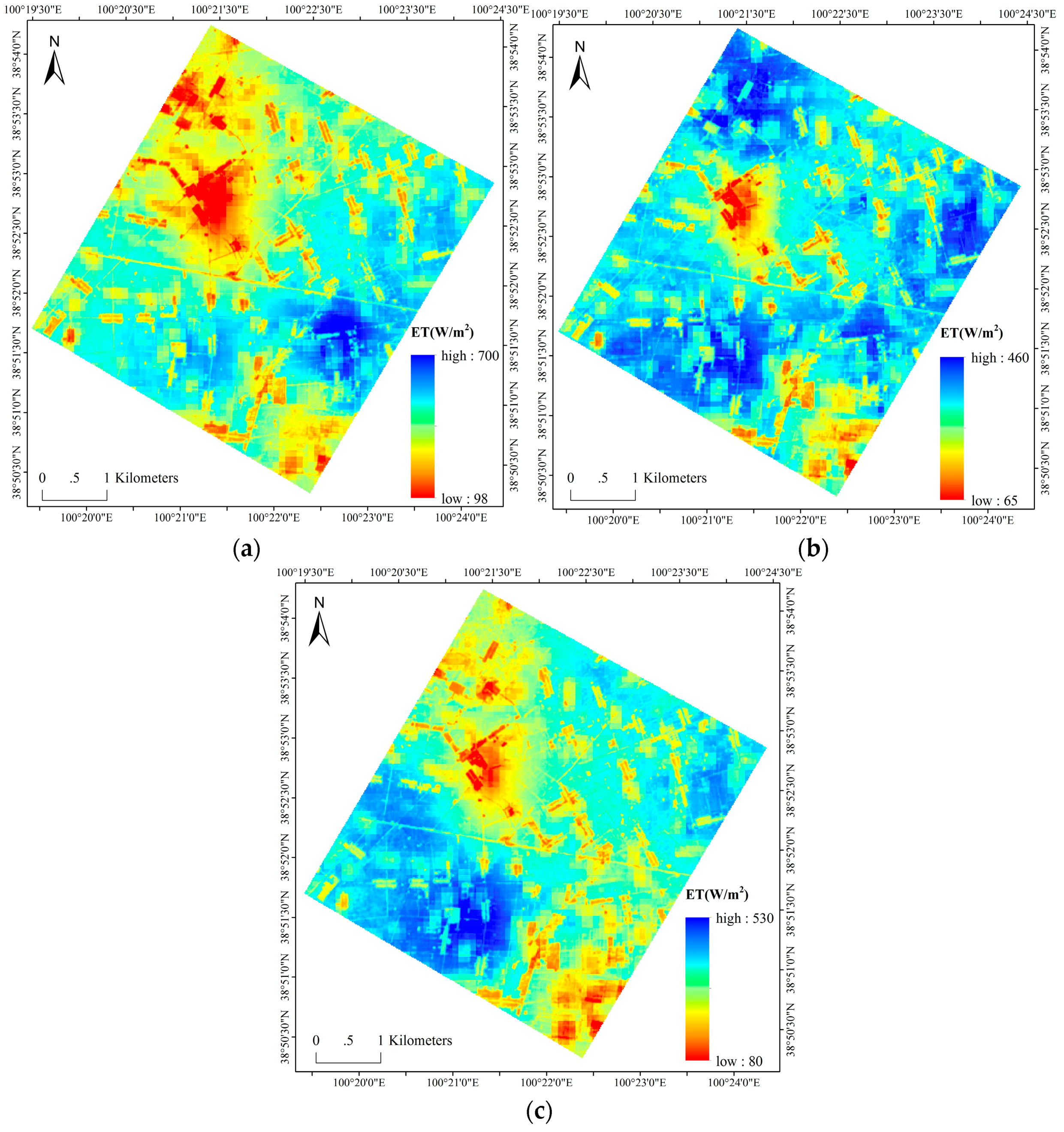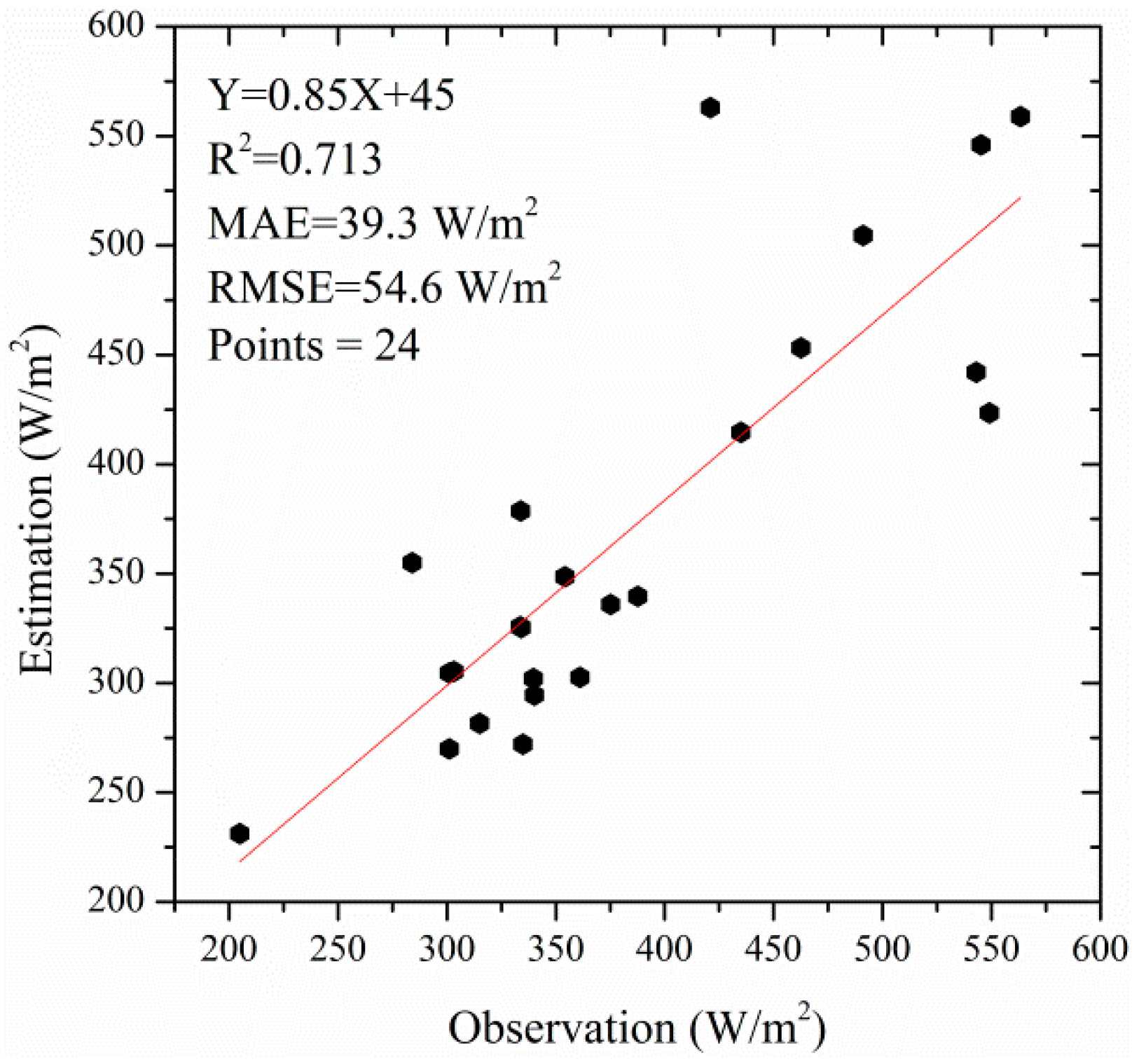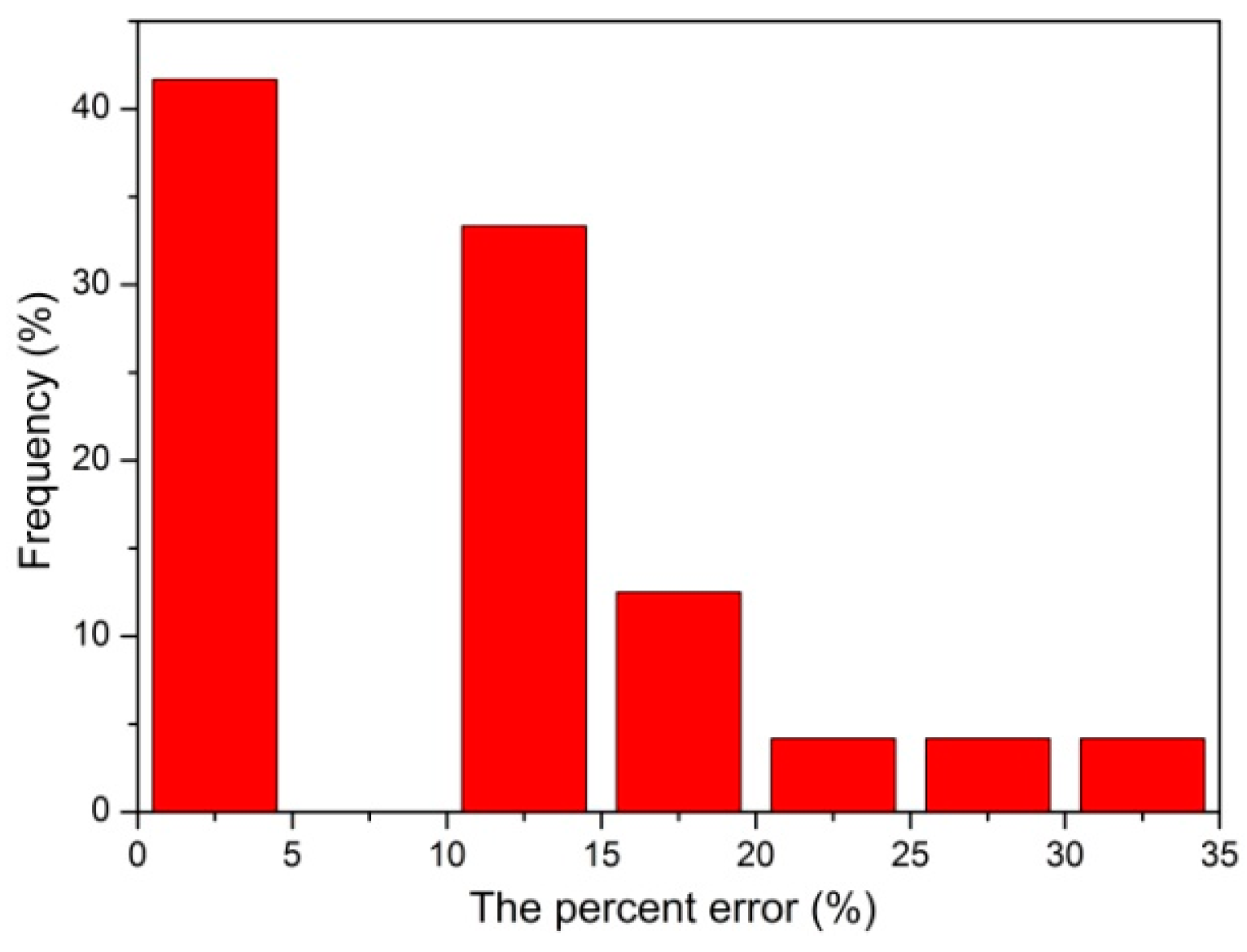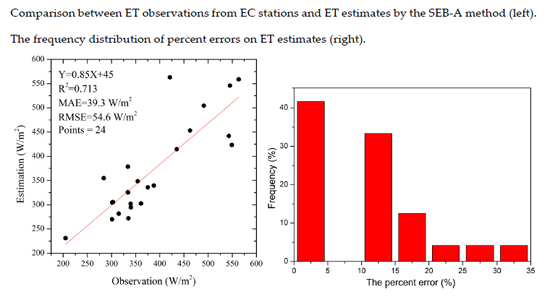1. Introduction
Evapotranspiration (ET), which is a combined process of evaporation and transpiration, is crucial to the hydrological cycle. It links energy and water exchanges among the hydrosphere, atmosphere and biosphere [
1,
2,
3,
4,
5]. ET is the largest outgoing water flux from the earth’s surface; most precipitation is lost in the form of ET with the percentage varying from region to region globally. In semi-arid regions, the amount of ET is roughly equivalent to the precipitation [
6]. Therefore, the accurate quantification of ET is critical to developing a greater understanding of local and global energy and water cycles, global climate change, land atmosphere interactions and ecosystem processes, and beneficial to improving applications in many fields, such as water resources management, drought monitoring and assessment [
7], irrigation scheduling, hydrological modeling, weather forecasts and so on [
8,
9,
10,
11,
12,
13]. Ground-based observations of ET have some advantages but the required ground instrumentation is available in a limited number of places and can only obtain localized values of ET, which often cannot satisfy the needs of regional-scale studies. In addition, the employment of instrumentations is always time consuming, labor intensive and sometimes subject to instrument failure [
9].
Recent developments in remote sensing have made it possible to acquire crucial variables for characterizing land surface interactions. Over the last two decades, the requirement of quantifying ET at a regional scale, together with the recent advances in satellite remote sensing technology, has led to many studies on mapping large-scale ET [
9,
11,
14,
15]. The surface energy balance algorithm based on the energy balance equation (SEB; Equation (1)), is one of the most widely used approaches for obtaining regional estimates of remotely sensed ET at multiple temporal and spatial scales [
9]. Energy and mass are exchanged between the land surface and the atmosphere [
16,
17]. When the heat fluxes that are transported by horizontal advection and consumed by photosynthetic vegetation are not considered, the one-dimensional form of the surface energy balance equation on an instantaneous time scale can be expressed as:
where
(W/m
2) is the net surface radiation,
(W/m
2) is the soil heat flux,
(W/m
2) is the sensible heat flux, and
(W/m
2) is the latent heat flux. In Equation (1), sensible heat flux can be calculated using the remotely sensed surface temperature, air temperature and a series of conductance formulas; estimates of
and
G are available using remote sensing or ground data, and hence, the latent heat flux is taken as a residual term of Equation (1) [
16,
17].
Based on how the sinks or sources of heat fluxes are parameterized between the earth’s surface and the atmosphere, SEB models can be divided into two categories: the single-source models and two-source models, or multi-source models [
18]. Single-source SEB models consider vegetation and soil to be a single unit and often utilize land surface temperature (LST) and empirical resistance corrections to derive the latent heat flux [
19]. Since they are highly dependent on empirical corrections, single-source SEB models are inappropriate for application over areas with partial vegetation cover, where significant errors would be found [
20,
21,
22]. To overcome the limitations associated with single-source SEB models in partially vegetated areas [
22], it is necessary to apply a two-source SEB model that separately simulates the heat and water exchange and the interactions between soil and atmosphere and between vegetation and atmosphere. Thus, in two-source SEB models, the component
H is partitioned between the soil and vegetation, and the component
LE is treated as the sum of evaporation from the soil surface and transpiration from vegetation.
From the aforementioned review of SEB models, we know that both single-source and two-source models are based on the energy balance equation (Equation (1)) that is founded on the premise of ignoring the energy transported by horizontal advection and consumed by photosynthesis [
16,
17]. Nevertheless, the presence of horizontal advection always characterizes exchanges in the near surface layer and contributes to the uncertainty of energy influxes [
23,
24]. Neglecting systematic sampling errors, systematic instrument bias, low and high frequency loss of turbulent fluxes and energy sinks, horizontal advection of heat and water vapor is regarded as the primary reason for the non-closure of the surface energy balance [
25,
26,
27]. To a certain region, uncertainties from horizontal advection on the surface energy balance have two aspects. One is the horizontal advection itself, which develops on heterogeneous surfaces and exerts profound influence on the energy balance equation. This has been reported in many previous studies [
28,
29]. Therefore, horizontal advection should be discussed as one reason for energy imbalances and regarded as a necessary item to add to the energy balance equation. The other uncertainty refers to the ground-based meteorological variables of air temperature, humidity and other auxiliary surface measurements inputted to the energy balance equation. These meteorological variables are actually measured and thus characterize the practical circumstance rather than describe the environment under the condition of energy balance closure, which means that the actually observed meteorological variables have already contained effects from the horizontal advection and would affect the energy balance equation when they are used as inputs. In conclusion, horizontal advection affects the energy balance equation directly through energy inputs or outputs, whereas ground-based observations impact the energy balance equation indirectly by including the effects of advection.
In view of the prevalence of the horizontal advection and its influence on the energy balance system, it is of great necessity to take into account the horizontal advection when applying SEB models to estimate ET. The objective of this paper is to propose an innovative method, the surface energy balance-advection (SEB-A) method, which is based on the energy balance equation and considers the horizontal advection as well to derive ET. The SEB-A method assumes that the energy consumed in the actual ET consists of two parts; one part is provided by the energy balance system and the other part is brought in by the horizontal advection. The former, called local ET, can be obtained by the modified energy balance equation (Equation (3)), and the calculation method of it is similar to previous studies that are on the SEB models; the latter, called exotic ET, can be calculated with the help of ground-based EC observations.
Section 2 describes the datasets used to assess the method.
Section 3.1 presents a description on the theory of calculating the local ET that is regulated by the energy balance system, and
Section 3.2 introduces approaches for deriving the exotic ET that is driven by the horizontal advection.
Section 4 shows the results of the SEB-A method that was applied on a regional scale by using variables retrieved from ASTER imagery and HJ-1A/B imagery and measured at meteorological and EC stations.
Section 5 discusses the advantages and limitations of the SEB-A method.
Section 6 concludes the work.
3. Methodology
In this section, the SEB-A method is described in detail. According to previous studies, horizontal advection is the main reason for surface energy imbalances [
25,
26,
27]. As a result, without regard to the internal generating mechanism of ET, the actual ET (
) is directly composed of two parts: the local ET (
) dominated by the energy balance system, and the exotic ET (
) given rise to by horizontal advection. This is inspired by the research of Zhang et al. [
34].
With no advection or when there is a surface energy balance closure, the actual ET (
) is equal to the local ET (
) and can be calculated by the energy balance equation. In reality, however, the horizontal advection would perturb the energy balance system and influence the energy balance equation. In this case, the actual ET (
) can be regarded as the sum of the local ET (
) and the exotic ET (
). The basic idea can be described as: the local driving force (the energy balance system) produces a local ET, and the exotic driving force (horizontal advection) changes the local ET by adding an exotic ET. The actual ET can be expressed as:
where
is the actual ET,
is the local ET, and
is the exotic ET. Three items are measured in energy units, W/m
2.
Figure 2 shows the principle of the SEB-A method. Because
contains both
and
, to estimate
, it is necessary to calculate the two parts:
and
.
3.1. Obtaining the Local ET,
The
can be determined by using the energy balance equation. Under the condition of energy balance closure, that is to say, there is no horizontal advection, the energy exchange between the land surface and atmosphere can be described by the modified energy balance equation (Equation (3)). Here, we also ignore the energy consumed by photosynthesis.
where
(W/m
2) and
(W/m
2) are the sensible heat flux and the latent heat flux driven by the energy balance system, respectively.
To calculate
, we need to know the sensible heat flux,
, as well. It is given as Equation (4):
where
is the air density,
(1004 J/(Kg·K)) is the specific heat at constant pressure of air,
(s/m) is the aerodynamic resistance,
(°C) is the aerodynamic temperature that is usually substituted with LST in applications [
35,
36], and
(°C) is the surface air temperature when there is no advection. Thus,
can be derived as:
Since there is no horizontal advection, the variables in Equation (5) should be acquired under the condition of energy balance closure. Among these variables, , , and LST are thought to remain the same, regardless of whether the energy balance is closed or not on an instantaneous time scale, whereas the other two variables, and , are specific and need to be calculated in the case of energy balance closure.
3.1.1. Calculation of
The measurement of the special
was through a laboratory experiment. In the experiment, the observational object was bare soil with a saturated soil water content. Parameters for the calculation including the radiometric soil surface temperature (
), actual surface vapor pressure (
) and evaporation (
), were measured with no wind. The formula used for deriving
is written as:
where
is the psychrometric constant (Pa/K),
(s/m) is the surface water vapor resistance and equals zero when the soil is fully saturated,
(Pa) is the surface saturated vapor pressure, and
(g) is the evaporation from the soil and measured by the weighing method.
In the experiment, we set five different initial air conditions with different
Ta and
RH, and we calculated
once per hour from 08:00 to 18:00 at the heights of 1 m and 0.5 m, respectively.
Table 1 and
Table 2 show the calculation results of
at the heights of 0.5 m and 1 m. In the tables,
Ta is the air temperature,
RH is the air relative humidity, and av. is the average value of
. The
varied around 150 s/m, and therefore, a value of
, 150 s/m, was determined and used to compute
.
3.1.2. Calculation of
Because
is specific under the condition of energy balance closure, it can be calculated by the energy balance equation (Equation (3)). Together with the sensible heat flux equation (Equation (4)) and the Bowen ratio, β, equation (Equation (7)),
can be derived as follows:
In Equation (8), the Bowen ratio,
, is determined according to an empirical equation presented by Zhang et al. [
37]. The equation is written as:
where
is an empirical coefficient that equals 0.66,
(W·m
−2·s
0.5·°C) is the simplified thermal inertia, and
and
are, respectively, the maximum and minimum thermal inertia that are determined from the trapezoid space formed by the vegetation index (VI) and LST. The simplified thermal inertia
is defined as:
where
(W/m
2) is the average net radiation during
(s) and
(s),
(°C) is the surface temperature when the satellite is passing, and
(°C) is the daily minimum surface temperature.
and
are the occurring times of
and
, respectively.
3.1.3. Calculation of and
Net radiation,
, can be derived by Equation (11); soil heat flux,
, can be estimated by an empirical equation (Equation (12)) that is used in some previous studies [
34].
where
is the surface albedo,
(W/m
2) is the downward shortwave radiation,
(W/m
2) is the downward longwave radiation,
is the surface emissivity,
(5.67 × 10
−8 W·m
−2·K
−4) is the Stefan–Boltzmann constant, and
is the fraction of vegetated surface.
3.2. Obtaining the Exotic ET,
Referring to
, it requires ground-based observations of latent heat flux to determine its value. For each EC station inputted to the method, we know its local ET, which can be estimated according to
Section 3.1 and its actual ET, which is measured by EC stations; then the exotic ET can be determined by Equation (2). However, the attained exotic ET,
, is ground-based and needs to be extended to a regional scale from a point scale. In the study, we used a spatial interpolation method, the inverse distance weighting (IDW), to interpolate the ground-based
to acquire the spatial distribution results. We assume that
is affected by the intensity of horizontal advection, which moves to other places through diffusion. Since the IDW interpolates according to the distance between two inputted objectives, it is appropriate to use it to acquire the spatial distribution of
. The process of interpolation is described as follows.
If the pixel covering the inputted EC station is expressed as Pixel
i with
, the exotic ET of other pixels (Pixel
x,
) around Pixel
i can be calculated by the IDW. Formulas can be written as:
where
(W/m
2) is the exotic ET of any pixel to be calculated,
is the number of the inputted EC stations,
is the weight,
(m) is the distance between the Pixel
and Pixel
x, and
is the specified power exponent.
5. Discussion
The SEB-A method ignores the inner mechanisms of ET; rather, it only concerns itself with the final estimates and thus the principle of it is clear to understand. Besides the principle, the SEB-A approach has another advantage, which uses the exact value of air aerodynamic resistance (150 s/m). Because the air aerodynamic resistance required by the method is under the condition of no advection, its value is exact, which will avoid complex computational processing of it in practice. In previous studies, the air aerodynamic resistance was difficult to determine. In addition, the surface air temperature, , needed is under the condition of no advection and can be estimated by remote sensing, which is another situation where the SEB-A method has an edge over previous methods that usually use interpolated air temperature from meteorological stations. Furthermore, the sensitivity analyses indicate that the SEB-A method is insensitive to the temperature difference between the air and the ground. This is promising because determining LST and is complex and may result in transferring errors. The insensitivity of improves the applicability of the SEB-A method.
Despite the advantages of the SEB-A method, it still carries some uncertainties. On the one hand, the approach requires plenty of ground-based observations to calculate the exotic ET driven by horizontal advection; therefore, the lack of sufficient ground-based observations would lead to inaccurate ET estimates. On the other hand, because the exotic ET is calculated by using EC observations, it is ground-based and needs to be extended from a point scale to a regional scale by the IDW. The IDW, however, interpolates according to the distance between inputted objectives with different values (see Equations (13) and (14)). As a result, the interpolation results may display in the form of circular high-value or low-value areas that do not exist in practice. Thus, the IDW may be inappropriate to handle the exotic ET. It is essential to find out the diffusion mechanism of the exotic ET and propose an appropriate way to address it.
The SEB-A method provides a way to take into account the horizontal advection when applying the energy balance theory and gives avenues for quantifying the exotic ET produced by the horizontal advection.
6. Conclusions
The study proposes the SEB-A method, which is innovative in that it considers the horizontal advection when applying the energy balance theory to estimate ET through remote sensing. The advantage of the SEB-A method is that it simplifies the ET process and regards the ET as regulated by two different driving forces: the local driving force and the exotic driving force. The local driving force is generated by radiation effects and can be described by the energy balance equation, whereas the exotic driving force is caused by the horizontal advection and can be expressed indirectly through ground-based EC observations. The idea makes the ET retrieval much simpler for the exact air aerodynamic resistance and for the quantification of the exotic ET. Model application and validation indicated that ET estimates from the SEB-A method had high accuracy, with an R2 of 0.713, a MAE of 39.3 W/m2 and an RMSE of 54.6 W/m2 between estimates and measurements. In addition, ET estimates had percent errors within 20% at more than 80% of the locations and could well demonstrate ET differences caused by heterogeneous underlying surfaces. The sensitivity results showed that the SEB-A method requested accurate estimation of Rn − G, but it was insensitive to the difference between surface and air temperatures.
Since the influence of horizontal advection on ET is ubiquitous in practice, it is necessary to consider the exotic ET caused by the horizontal advection. The SEB-A method puts forward the way of utilizing ground-based EC measurements to quantify the exotic ET, which is verified with high accuracy. If remote sensing data and ground-based measurements including meteorological variables and surface fluxes are available, the SEB-A method can perform well. However, the method cannot work well when the ground-based measurements is insufficient.

